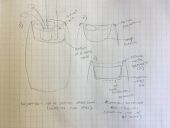Hi Steve! Roy and Galadriel have already mentioned two of the things I was going to suggest -- self-watering containers, and some form of slow-watering solution. (Though, Galadriel, I tried your method a couple of years ago and found that the 'corking' effect didn't really work for me and the whole lot drained out pretty fast. Did you have any thoughts on that? It might have been a soil problem; that particular container had quite poor soil.)
Another slow-watering option if you have large containers is a variation on an idea which I think originates in parts of Africa but I picked up from
Permaculture Magazine: bury a porous (e.g. ceramic) pot in the soil, with an inch or so above soil level to keep the soil out of it. If it has a drainage hole in the bottom you'll want to stick a cork or similar in it. Fill it with water and it will gradually leak out into the surrounding soil. Ideally you should cover it with something to prevent direct evaporation but I haven't yet constructed anything suitable and I found that it worked OK anyway. I've used that method in raised beds and in a biggish container, but in the container I could only fit quite a small pot so it's not a perfect solution.
You can also mulch to reduce water evaporation from the soil, if you aren't already. But yeah, the bottom line is that watering is a problem for container gardens and self-watering containers are the closest to a solution I've found. If it helps, ceramic pots lose water several times faster! (I find this annoying; I prefer ceramic as a material but it's much less practical.)
No idea if this would work, or offend your HOA, but could you paint your containers white to reduce the soil-warming effect?
Onto your other question, of soil. I'm afraid I don't have a solution there, either; I don't think it's possible to truly create a 'permaculture pot' in the same way that you can create 'permaculture soil' in a regular-sized garden. In my experience the soil in a pot does shrink a bit over time, but not enough to make enough space to really replenish the organic material.
With big pots you can (depending on conditions) start to get a bit of soil life going in there, especially if you're making your own
compost -- I've found happy worms in big pots on hard surfaces and assume they must have come in with the compost!
With perennials I try to top up as much as possible, take a bit out at the sides if I have to to make more space, and use compost tea as an occasional feed. With annuals, I turf the whole lot out when the pot is empty, mix it up with nice new stuff, and shove it all back in again. These days my container gardening is in the context of a (tiny) 'proper' garden and I do sometimes just chuck really manky potting compost into the compost pile as a way of mixing it up. NB I am aware that annuals aren't very 'permaculture' but I am a strong proponent of growing things that you love and will eat, and sometimes annuals do tick that box. Tomatoes, courgettes, and broad beans, for me personally, are worth growing even as annuals; and tomatoes do very well in containers which is handy!





 that won't offend the HOA gods and yet will possibly help me manage my water better? The overwatering is not good for many of my plants and yet they will become over-stressed without it. How do you overcome this with container gardening? Thanks, I look forward to your response!
that won't offend the HOA gods and yet will possibly help me manage my water better? The overwatering is not good for many of my plants and yet they will become over-stressed without it. How do you overcome this with container gardening? Thanks, I look forward to your response! 2
2




















































